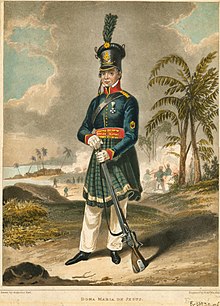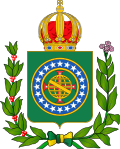Maria Quitéria
Maria Quitéria | |
|---|---|
 Dona Maria de Jesus, contemporary drawing by Augustus Earle, 1824. | |
| Born | Feira de Santana, Bahia, Colonial Brazil |
| Died | 21 August 1853 (aged 61) Salvador, Bahia, Empire of Brazil |
| Allegiance | |
| Service/ | |
| Years of service | 1823 - 1824 |
| Rank | Lieutenant |
| Battles/wars | |
| Awards | Order of the Southern Cross |
| Other work | Farmer |
Maria Quitéria (27 July 1792 – 21 August 1853) was a Brazilian lieutenant and national heroine. She served in the Brazilian War of Independence in 1822–23 dressed as a man. She was promoted to cadet and Lieutenant and decorated with the Imperial order. She has been called "Brazilian Joan of Arc,"[1] and has become a kind of national legendary figure. Quitéria was the first woman to serve in a military unit in Brazil. She, along with Maria Filipa de Oliveira (died 1873) and Sister Joana Angélica (1761-1822), are known as the three Bahian women resistance fighters in the War of Independence against the Portuguese.[2][3]
Against her father's will, an unmarried Maria Quitéria enlisted in the Brazilian army, as a man, in October 1822. Until June 1823, she fought in several battles against the Portuguese in Bahia, where she lived. Maria Quitéria's father outed her as a woman once he discovered her betrayal—but because of her skill in battle, she was allowed to continue to fight. She was promoted to cadet in July 1823, and then to lieutenant in August, where she was received and decorated by the Emperor.[4]
Few details are known about the life of Maria Quitéria. The historian Aristides Milton, a childhood friend of the poet Castro Alves, grandson of the major who defended Maria Quiteria for her skill with weapons and recognized military discipline, and incorporated it her to his troops, considers Maria Quiteria "a lady as brave as honest" in the Ephemerides Cachoeiranas. She is briefly mentioned by English travel author Maria Graham (later Lady Callcott) in her book Journal of a Voyage to Brazil: "Maria de Jesus is illiterate, but lively. She has clear intelligence and acute perception. I think that if they educated her, she would become a notable personality. One observes nothing masculine in her conduct, rather she is of gentle and friendly manners."[5]
Personal life[edit]
Maria Quitéria de Jesus was born on June 27, 1792, in Licurizeiro, in the parish of São José das Itaporocas (now located in Feira de Santana), Bahia. She was the eldest daughter of a farmer, Gonçalo Alves de Almeida, and his wife, Quitéria Maria de Jesus, who died when the young Maria Quitéria was just 10 years old. Her father would go on to remarry on two more occasions, once with Eugenia Maria dos Santos, and later to Rosa Maria de Brito.[6][7] Although Maria received no formal education, she would have practiced the skills necessary to farming, such as riding, hunting, and using firearms—these skills would serve her in the military as well.
After her time serving in the war, Quitéria married Gabriel Pereira Brito (who was a former lover of hers) and had one daughter with him, named Luisa. Near the end of her life, the widowed Maria Quitéria was nearly blind, and in 1853 she died in relative obscurity and poverty near Salvador. Her remains were placed in the ossuary of the Church of the Blessed Sacrament of Saint Anne (Portuguese: Igreja do Santíssimo Sacramento e Sant'Ana), in the neighborhood of Nazaré in Salvador.[8][3] It was not until years later that her legacy was revived.
Legacy[edit]
After her death, Maria Quitéria was memorialized nationally in a number of ways. In 1953, one hundred years after her death, a bronze medal was issued by the military bearing Maria Quitéria's likeness. It is called the "Medal of Maria Quitéria" and was issued to both civilians and military personnel for valuable contributions to military efforts. By presidential decree in 1996, Maria Quitéria was proclaimed Patron of the Corps of Support Staff Officers of the Brazilian Army.[4]
The best-known painting of Maria Quitéria is a work by Italian painter Domenico Failutti from 1920 titled Portrait of Maria Quitéria de Jesus Medeiros (Portuguese: Retrato de Maria Quitéria de Jesus Medeiros). She is depicted standing alone, holding a rifle and wearing the uniform of a Brazilian lieutenant. The work can be found in the Museu Paulista at the University of São Paulo.[9]
References[edit]
- ^ "A História e Biografia de Maria Quitéria". historia.com.br. Archived from the original on September 23, 2013. Retrieved 20 April 2015.
- ^ Nassif, Lourdes (28 January 2015). "Quiteria fought for the army, but 120 years later women were admitted". jornalggn.com.br. Archived from the original on May 21, 2022.
- ^ a b "Saiba onde estão restos mortais das três mulheres ícones da luta pela independência do Brasil na Bahia". G1 (in Portuguese). Globo. July 2, 2019. Archived from the original on July 2, 2019. Retrieved July 3, 2019.
- ^ a b "DECRETO DE 28 DE JUNHO DE 1996". planalto.gov.br. Archived from the original on December 30, 2013. Retrieved 2017-04-23.
- ^ Soares, Nara Marques. "Maria Graham Callcott: revisão bibliográfica e considerações sobre sua escrita". academia.edu. Archived from the original on February 15, 2024.
- ^ Vainfas, Ronaldo, ed. (2002). "Maria Quitéria". Dicionário do Brasil Imperial (1822-1889). Rio de Janeiro: Editora Objetiva. pp. 523–525.
- ^ "María Quitéria de Jesús, The heroine of Brazil". amuraworld.com. Archived from the original on June 3, 2020.
- ^ "A História e Biografia de Maria Quitéria". ahistoria.com.br (in Brazilian Portuguese). Archived from the original on September 23, 2013. Retrieved 2017-04-23.
- ^ "Home | Museu Paulista". mp.usp.br (in Brazilian Portuguese). Archived from the original on August 29, 2012. Retrieved 2017-04-23.

